You need to see Saturn in the night sky this week
The planet will be at opposition, with its rings visible to sky gazers.

CELESTIAL OBJECTS COME AND GO FROM OUR VIEW IN THE NIGHT SKY, as they fling by or orbit around the Sun. Whether it be the full moon or a meteor shower or just the best night to see Mars, we're here to direct your eyes skyward and tell you to look up and appreciate the wonders of space from Earth.
This week, we're asking you to marvel at the beauty of the planet Saturn as it appears at its brightest throughout the month of August during its opposition from the Sun.
Saturn is the second-largest planet of the Solar System, with the gas giant Jupiter taking the number one spot. The planet is a chaotic world surrounded by 62 moons, and broken up pieces of ice and rock that encircle the planet as a swirl of rings.
Astronomers believe that Saturn's rings are made up of broken pieces of comets, asteroids and perhaps ancient moons that were violently torn apart by Saturn's gravitational force and remained in orbit around the planet.
Saturn is surrounded by rings of broken off pieces of gas and ice, coated with dust.
And this gas giant, along with its rings, will appear at its brightest in the night sky throughout the month of August, giving sky gazers prime viewing time of Saturn. As the sixth planet away from the Sun, Saturn is the most distant planet that can be viewed by the naked eye.
Saturn reached opposition on July 20 and will be visible for sky gazers throughout the month of August, appearing at its brightest until August 9. A planet coming in opposition means that they come directly opposite of the Sun, perfectly aligning with the Earth and the host star.
As our planet flies directly between the Sun and Saturn, the planet will be at its closest to Earth and visible to us Earthlings throughout the night. Saturn will appear as a golden star, located right next to another bright planet in the sky, Jupiter.
The planet will rise in the southeastern sky, and stay there until dawn in front of the constellation Sagittarius.
Saturn's disk and rings will be fully illuminated from our view. You can view the planet with the unaided eye, but a pair of binoculars will help you see it better. Additionally, if you want to get a view of Saturn's illuminated rings, then a small telescope will come in handy.
You may even be able to spot one or two of Saturn's moons using a telescope.
If you live in a crowded city like New York, it is best to get as high up as possible in order to minimize light pollution therefore going on a balcony or rooftop is highly recommended.
You also want to block out any light coming from screens of electronic devices, or flashlights and allow your eyes to get accustomed to the darkness for around 30 minutes before you look up.
Saturn's position will change throughout the night, moving higher in the sky.
Saturn and Jupiter will appear bright together as a pair of shining stars until December 2020.